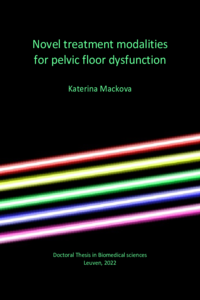Novel treatment modalities for pelvic floor dysfunction
Nové způsoby léčby poruch pánevního dna
dizertační práce (OBHÁJENO)

Zobrazit/
Trvalý odkaz
http://hdl.handle.net/20.500.11956/171919Identifikátory
SIS: 182033
Kolekce
- Kvalifikační práce [3146]
Autor
Vedoucí práce
Oponent práce
Džupová, Olga
Čelko, Alexander
Fakulta / součást
3. lékařská fakulta
Obor
Preventivní medicína a epidemiologie
Katedra / ústav / klinika
Ústav pro péči o matku a dítě
Datum obhajoby
18. 2. 2022
Nakladatel
Univerzita Karlova, 3. lékařská fakultaJazyk
Angličtina
Známka
Prospěl/a
Naším cílem bylo testování vybraných nových léčebných modalit pro dysfunkci pánevního dna a genitourinární syndrom menopauzy. Oba stavy jsou u žen běžné a negativně ovlivňují kvalitu jejich života. Současné možnosti léčby však nejsou optimální. Náš výzkum jsme zahájili rozsáhlým studiem literatury. Nejprve jsme shrnuli informace o zvířecích modelech a jejich vlastnostech pro zkoumání patofyziologie POP a nových terapií. Systematicky jsme prohledali 7426 článků, z nichž 51 splnilo kritéria pro zařazení. Ze všech zkoumaných zvířat se spontánně vyvine POP pouze u primátů, jejich použití je však kontroverzní. Došli jsme k závěru, že mnoho studií má metodologické nedostatky a postrádá standardizaci, ale že existuje několik zvířat, která lze použít jako chirurgický model pro POP, každé z nich je vhodně pro jiné účely. Pro náš pozdější výzkum jsme vybrali krysu pro opravu POP syntetickou síťkou. Systematicky jsme také prozkoumali literaturu o objektivních účincích neablativního Er: YAG LASER na kůži a vaginální stěnu. Identifikovali jsme 7187 článků a 15 zahrnuli do našeho přehledu, z nichž pouze 4 testovaly Er: YAG LASER na vaginální tkáni. Energie Er: YAG LASERU indukuje měřitelné změny v hlubších vrstvách kůže nebo vaginální stěny procesem buněčné aktivace, produkce extracelulární matrix a remodelace...
We aimed to test selected novel treatment modalities for pelvic floor dysfunctions and genitourinary syndrome of menopause. Both conditions are common in female, they negatively affect their quality of life, and current treatment options are not optimal. We started our research with an extensive literature search. First, we summarized the information on animal models for, and the utility they may have in the investigation of the pathophysiology of POP and novel therapies. We systematically searched 7426 articles from which 51 fulfilled the inclusion criteria. From all screened animals, only the non-human primate develops POP spontaneously, however their use is controversial. We concluded that many studies have methodological shortcomings and lack standardization in reporting outcomes. Also, several other animals can be used as a model of surgery for POP, each of them with different purposes. For our later research we chose the rat model to simulate POP repair with synthetic mesh. We also systematically reviewed the literature on the objective effects of non-ablative Er:YAG LASER on the skin and vaginal wall. We identified 7187 articles of which we included 15 in our review, including four that tested Er:YAG LASER on vaginal tissue. Er:YAG LASER energy induces measurable changes in the deeper skin...
